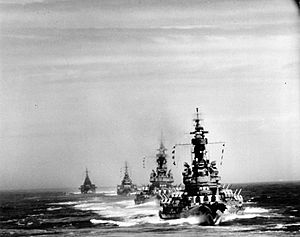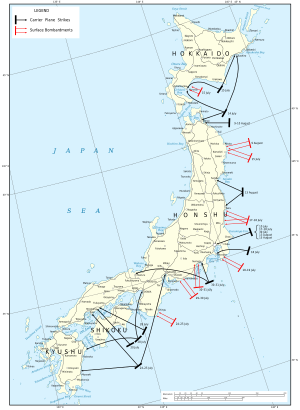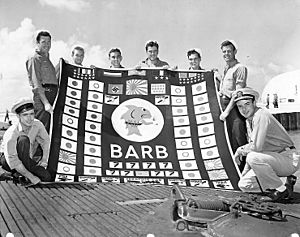Allied naval bombardments of Japan during World War II facts for kids
Quick facts for kids Allied naval bombardments of Japan |
|||||||
|---|---|---|---|---|---|---|---|
| Part of the Pacific War, World War II | |||||||
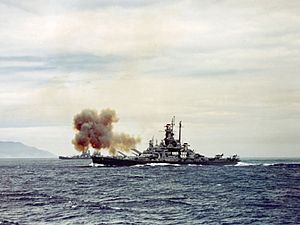 USS Indiana bombarding Kamaishi, Japan on 14 July 1945 |
|||||||
|
|||||||
| Belligerents | |||||||
| Casualties and losses | |||||||
| 32 (POWs killed in the bombardments of Kamaishi) | Up to 1,739 killed Up to 1,497 wounded Damage to industrial facilities Damage to urban areas |
||||||
During the final weeks of World War II in July and August 1945, powerful warships from the United States Navy, the Royal Navy (Britain), and the Royal New Zealand Navy attacked Japan. These ships fired their big guns at factories and military bases along Japan's coast.
Most of these attacks were carried out by large battleships and cruisers. They caused a lot of damage to the factories and nearby towns. One main reason for these attacks was to make the Japanese military use their reserve airplanes. The Allies hoped to destroy these planes in battle.
However, the Japanese military did not attack the Allied ships. So, none of the Allied warships were damaged during these bombardments.
The main bombardments started on July 14 and 15, 1945. US Navy ships attacked the cities of Kamaishi and Muroran. A few days later, American and British ships attacked Hitachi. Other attacks hit areas like Nojima Saki, Shionomisaki, Hamamatsu, and Shimizu. The last big bombardment happened on August 9, when Kamaishi was attacked again.
These naval attacks hurt Japan's ability to make goods for the war. They also made many Japanese people realize that the war was likely lost. Sadly, up to 1,739 Japanese people died in these attacks, and about 1,497 were injured. The only Allied casualties were 32 prisoners of war (POWs) who were killed during the bombardments of Kamaishi.
Contents
Why Did the Bombardments Happen?
By mid-1945, Japan was already facing many attacks. United States Army Air Forces (USAAF) B-29 Superfortress bombers were regularly bombing Japanese cities and factories. Allied submarines and surface ships had also cut off most of Japan's trade routes. This meant Japan couldn't get important supplies.
Because of fuel shortages, most of the Imperial Japanese Navy's ships stayed in port. The Japanese also saved their airplanes for a big battle they expected later in the year. This battle would be when the Allies tried to invade Japan.
Allied naval commanders decided to use their battleships to attack Japanese coastal cities. They hoped these attacks would force Japan to use its reserve aircraft. If Japan sent its planes to fight the ships, Allied fighter planes could shoot them down. However, the Japanese military leaders had expected these kinds of attacks. They decided not to use their planes against the naval forces. Instead, they kept their aircraft hidden for the expected invasion.
The Attacks Begin
First Attack on Kamaishi
On July 1, 1945, the United States Third Fleet left the Philippines. It was led by Admiral William Halsey. His plan was to attack Japanese factories and military sites. US Navy submarines went ahead to check for naval mines. B-29 and B-24 planes also flew over Japan to find targets.
The main part of the Third Fleet, called Task Force 38 (TF 38), began air attacks on July 10. Their planes hit targets near Tokyo. Then, TF 38 moved north. On July 14, they started bombing Hokkaido and northern Honshu. These areas had not been attacked much before. The American planes faced little resistance. They sank many Japanese ships and destroyed some aircraft.
The first naval bombardment happened on July 14. A group of ships, Task Unit 34.8.1 (TU 34.8.1), was sent to attack the ironworks in Kamaishi. This city had 40,000 people, and its ironworks was one of Japan's largest. However, it was not running at full power due to a lack of materials. Allied prisoners of war were forced to work at this ironworks.
TU 34.8.1 included the battleships USS South Dakota, Indiana, and Massachusetts. It also had the heavy cruisers USS Quincy and Chicago, plus nine destroyers.
The ships started firing at the ironworks around noon. They moved closer to the city but stayed away from possible mines. The bombardment lasted over two hours. The ships fired many large shells. Most shells hit the ironworks. However, the explosions also caused fires in homes across Kamaishi.
American planes could not help spot targets because of the smoke. No Japanese planes or coastal guns fired back. After the attack, photos showed the ironworks were damaged. Later, the Allies learned the ironworks were badly hit and had to stop production for a while. This attack also destroyed 1,460 houses and killed 424 civilians. Five Allied prisoners of war also died.
Muroran Attack
On the night of July 14/15, another group of ships, TU 34.8.2, attacked Muroran. This city is on the southeast coast of Hokkaido. This group had the battleships Iowa, Missouri, and Wisconsin. It also included the light cruisers Atlanta and Dayton, and eight destroyers. Admiral Halsey was on the Missouri during this attack.
The targets were the Japan Steel Company and the Wanishi Iron Works. The bombardment started at dawn on July 15. The battleships fired many 16-inch shells. Hazy weather made it hard for planes to see where the shells landed. Still, the industrial plants were damaged. This caused a loss of iron and coke production. Buildings across the city were also heavily damaged.
The ships were visible from shore for over six hours. Admiral Halsey was worried about air attacks during this time. But the Japanese did not attack. This convinced Halsey that they were saving their planes for the expected invasion.
Hitachi Bombardment
After the attacks on Hokkaido and northern Honshu, the Allied fleet refueled. On July 17, American and British carriers attacked targets north of Tokyo. Later that day, TU 34.8.2 left the carrier force to bombard Hitachi. This city was about 80 kilometers (50 miles) northeast of Tokyo.
This force included battleships Iowa, Missouri, Wisconsin, North Carolina, Alabama, and the British battleship HMS King George V. It also had light cruisers Atlanta and Dayton, plus American and British destroyers.
The attack on Hitachi happened on the night of July 17/18. Rain and fog made it hard to see targets. The ships used radar to aim. They fired at nine industrial sites. The American battleships fired over 1,200 shells, and the British battleship fired over 260 shells.
The attack on Hitachi had mixed results. Only three of the nine targets were hit, and damage to factories was "slight." However, the city's living areas and services were badly damaged. A B-29 bomber raid the next night caused even more damage to the city. Some Japanese people said the naval bombardment felt more terrifying than the air attacks.
Other Coastal Attacks
On July 18, Allied planes attacked the Tokyo area again. That night, a group of cruisers and destroyers fired at a radar station at Cape Nojima. They fired for five minutes but did not hit it.
Later, from July 24 to 28, the Allied fleet attacked Kure and the Inland Sea. On the night of July 24–25, the same cruiser group patrolled the Kii Channel. They bombarded a seaplane base and a radio station. This attack was short and caused little damage.
Hamamatsu Bombardment
On July 29, a group of warships was sent to bombard Hamamatsu. This city is on the south coast of Honshu. The force included the same ships that attacked Kamaishi, plus the British battleship King George V and three British destroyers. Hamamatsu had already been heavily damaged by air raids.
The British and American ships attacked their targets separately. King George V fired at a factory making aircraft parts. It fired many shells for 27 minutes. Even with good visibility, little damage was done to the factory itself. However, the shelling caused workers to stay home and hurt vital services, making the factory stop production.
The American ships also shelled a railway factory and other industrial sites. The railway factory stopped working for about three months. Two bridges on an important railway line were fired upon but not hit. No Japanese planes or shore guns fired back. This was the last time a British battleship fired its guns in battle.
Shimizu Attack
The next bombardment was on the night of July 30/31. A group of destroyers searched the Suruga Gulf for Japanese ships. They found none. In the early hours of July 31, they sailed deep into the gulf. They fired over 1,100 shells at a railway yard and an aluminum plant in Shimizu. The aluminum plant was hit, but it was already barely producing due to lack of materials. The railway yard was not damaged.
Second Attack on Kamaishi
In late July and early August, the Allied fleet moved away from Japan to avoid a typhoon and resupply. Then, on August 9 and 10, carrier planes attacked many Japanese aircraft on airfields in northern Honshu. They claimed to have destroyed 720 Japanese planes.
As part of these operations, Kamaishi was bombarded again on August 9. The Allies mistakenly thought the ironworks had not been badly damaged the first time. TU 34.8.1 attacked again. This time, more ships joined, including the heavy cruisers USS Boston and Saint Paul, the British light cruiser HMS Newfoundland, and the New Zealand light cruiser HMNZS Gambia. The British battleship King George V could not join due to mechanical problems.
The Allied ships started firing at the ironworks and docks in Kamaishi around 1 p.m. The bombardment lasted almost two hours. They fired many shells, including 16-inch, 8-inch, and 6-inch shells. HMNZS Gambia fired the last shots. During the attack, some Japanese planes approached, and two were shot down by Allied fighters.
This second bombardment caused more damage than the first. Large amounts of iron were destroyed. The attack also hit homes near the ironworks, destroying 1,471 houses and killing 281 civilians. One of the prisoner of war camps in Kamaishi was destroyed, killing 27 Allied prisoners.
A final bombardment was planned for August 13 but was canceled. This was due to the battleship's mechanical issues and the atomic bombings of Hiroshima and Nagasaki. Japan surrendered on August 15, ending the war.
Submarine Attacks
Two US Navy submarines also attacked locations in Japan in June and July 1945. On June 20, USS Barb arrived off Japan's northern islands. This submarine had a special rocket launcher for shore attacks. On June 22, it fired 12 rockets at Shari in Hokkaido.
Later, on July 2, Barb used its deck gun to bombard Kaiyo in Sakhalin. This attack destroyed three fishing boats and caused fires. The next day, the submarine fired more rockets at Shisuka. On July 23, a small group of eight men from Barb landed on Sakhalin. They planted explosives on a railroad track. A passing train triggered the explosives, killing 150 people.
On July 24, Barb fired rockets at Shirutoru and Kashiho. As the submarine returned to base, it shelled Chiri on July 25 and Shibetoro on July 26. The attack on Shibetoro targeted a shipyard and destroyed 35 new fishing boats.
Another submarine, USS Trutta, fired shells at Hirado Shima island on June 24. This attack was a trick. It was meant to make the Japanese think American submarines would leave the Sea of Japan through the Tsushima Strait. In reality, they planned to leave much further north.
What Were the Results?
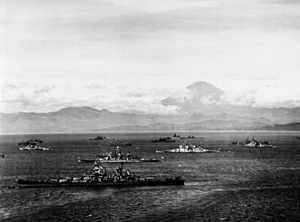
The naval bombardments did not make the Japanese military use their reserve planes, which was a main goal. However, they did disrupt Japan's steel industry. The important Kamaishi and Wanishi Iron Works were heavily damaged. The Allied gunners were very accurate, hitting critical parts of the factories.
After the war, experts found that the damage from naval shells was less than what Allied aircraft bombs could do. Still, the bombardments were considered successful because there was little risk to the Allied ships.
The attacks also affected the morale of Japanese civilians. People who experienced both air and naval bombardments found the naval attacks more terrifying. This was because they were unpredictable and lasted longer. Even if factories were not destroyed, production often dropped because workers stayed home or were less productive.
The sight of Allied warships off the coast also convinced many Japanese people that the war was lost. However, the feelings of civilians did not directly lead to the Japanese Government's decision to surrender.
In 1949, Japan reported that naval bombardments and other non-bombing attacks caused 3,282 casualties. This included 1,739 deaths, 46 missing people, and 1,497 wounded.
See Also


